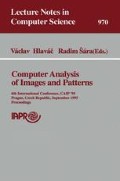Abstract
We present a framework for accurate and robust extraction of parametric models of different types. The framework consists of four components: exploration, selection, fit, and a final selection. The exploration is a dynamic data-driven masking technique that proposes a set of models from which the selection chooses the ones that explain the data with minimal description length. Selection is performed by tabu search, a discrete optimization technique that outperforms annealing techniques on many classical optimization problems. Our robust fitting technique, which increases the accuracy of the selected models, may change the classification of data elements which requires the final selection. We apply our framework to simultaneously extract different geometric models from 2D and 3D data.
A. L. acknowledges the support provided by the Austrian National Fonds zur Förderung der wissenschaftlichen Forschung under grant S7002MAT and by the Ministry for Science and Technology of The Republic of Slovenia (Project J2-6187).
Preview
Unable to display preview. Download preview PDF.
References
R. C. Bolles and M. A. Fischler. A paradigm for model fitting with applications to image analysis and automated cartography. Comm. ACM, 24(6):381–395, 1981.
A. Califano, R. M. Bolle, and R. W.Taylor. Generalized neighborhoods: A new approach to complex parameter feature extraction. In Proc. of the Conf. on CVPR, pages 192–199, 1989.
D. S. Chen. A data-driven intermediate level feature extraction algorithm. IEEE Trans. on Pattern Analysis and Machine Intelligence, 11(7):749–758, July 1989.
T. Darrell, S. Sclaroff, and A. Pentland. Segmentation by minimal description. In Proc. of the Third Intern. Conference on Computer Vision, pages 112–116, Osaka, Japan, Dec. 1990.
F. Glover and M. Laguna. Tabu search. In C. R. Reeves, editor, Modern heuristic techniques for combinatorial problems, pages 70–150. Blackwell Scientific Publications, 1993.
L. Hérault and R. Horaud. Figure-ground discrimination: A combinatorial optimization approach. IEEE Trans. on PAMI, 15(9):899–914, Sept. 1993.
J. Kittler and P. L. Palmer. Robust and statistically efficient detection of parametric curves in 2D images. In Performance versus Methodology in Computer Vision, pages 111–123, Seattle, WA, June 24–25 1994. NSF/ARPA Workshop.
V. F. Leavers. The dynamic generalized Hough transform: Its relation to the probabilistic Hough transform and an application to the concurrent detection of circles and ellipses. CVGIP: Image Understanding, 56(3):381–398, Nov. 1992.
A. Leonardis, A. Gupta, and R. Bajcsy. Segmentation as the search for the best description of the image in terms of primitives. In Proc. of the Third ICCV, pages 121–125, Dec. 1990.
A. P. Pentland. Part segmentation for object recognition. Neural Computation, 1:82–91, 1989.
P. L. Rosin. Ellipse fitting by accumulating five-point fits. Pattern Recognition Letters, 14:661–669, Aug. 1993.
G. Roth and M.D. Levine. Geometric primitive extraction using a genetic algorithm. IEEE Trans. on Pattern Analysis and Machine Intelligence, 16(9):901–905, 1994.
C.V. Stewart. A new robust operator for computer vision: Theoretical analysis. In Proc. of the IEEE Conf. Computer Vision and Pattern Recognition, pages 1–8, June 1994.
M. Stricker. A new approach for robust ellipse fitting. Proc. of the Third Intern. Conference on Automation, Robotics and Computer Vision (Singapore), 2:940–945, Nov. 1994.
M. Stricker and A. Leonardis. Exsel++: A general framework to extract parametric models. Technical Report 159, ETH-Zurich, Image Science, Gloriastr. 35, CH-8092 Zurich, Switzerland, Feb. 1995.
L. Xu and E. Oja. Randomized Hough transform: Basic mechanism, algorithms, and computational complexities. CVGIP: Image Understanding, 57(2):131–154, March 1993.
Author information
Authors and Affiliations
Editor information
Rights and permissions
Copyright information
© 1995 Springer-Verlag Berlin Heidelberg
About this paper
Cite this paper
Stricker, M., Leonardis, A. (1995). ExSel++: A general framework to extract parametric models. In: Hlaváč, V., Šára, R. (eds) Computer Analysis of Images and Patterns. CAIP 1995. Lecture Notes in Computer Science, vol 970. Springer, Berlin, Heidelberg. https://doi.org/10.1007/3-540-60268-2_284
Download citation
DOI: https://doi.org/10.1007/3-540-60268-2_284
Published:
Publisher Name: Springer, Berlin, Heidelberg
Print ISBN: 978-3-540-60268-2
Online ISBN: 978-3-540-44781-8
eBook Packages: Springer Book Archive

